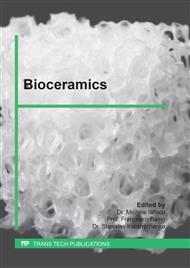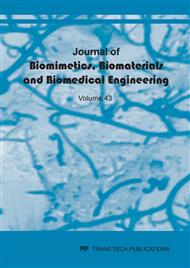[1]
D. Gopi, V. Collins Arun Prakash, L. Kavitha. Evaluation of hydroxyapatite coatings on borate passivated 316L SS in Ringer's solution. Mater. Sci. Eng C.29 (2009) 955-958.
DOI: 10.1016/j.msec.2008.08.020
Google Scholar
[2]
X. Yunchang, H. Kaifu, T. Hu, T. Guoyi, K.C. Paul. Influence of aggressive ions on the degradation behavior of biomedical Magnesium alloy in physiological environment. Acta. Biomater, 4(2008) 2008-2015.
Google Scholar
[3]
G.S. Frankela, N. Sridhar. Understanding localized corrosion. Mater. Today. 11(2008) 38-44.
Google Scholar
[4]
A.M. Al-Zahrani, H.W. Pickering. IR voltage switch in delayed crevice corrosion and active peak formation detected using a repassivation-type scan. Electrochim. Acta.50 (2005) 3420-3435.
DOI: 10.1016/j.electacta.2004.12.017
Google Scholar
[5]
T.M. Sridhar, U. Kamachi Mudali, M. Subbaiyan. Preparation and characterisation of electrophoretically deposited hydroxyapatite coatings on type 316L stainless steel. Corros Sci.45 (2003) 237-252.
DOI: 10.1016/s0010-938x(02)00091-4
Google Scholar
[6]
T. Eliades, H. Pratsinis, D. Kletsas, G. Eliades, M. Makou. Characterization and cytotoxicity of ions released from stainless steel and nickel-titanium orthodontic alloys. Am J Orthod Dento facial Orthop. 125 (2004) 24-29.
DOI: 10.1016/j.ajodo.2003.09.009
Google Scholar
[7]
A. Parsapour, S.N. Khorasani, M.H. Fathi. Effect of Surface Treatment and metallic coating on corrosion behavior and biocompatibility of surgical 316L Stainless Steel Implant. J. Mater. Sci. Technol. 28 (2012) 125-131.
DOI: 10.1016/s1005-0302(12)60032-2
Google Scholar
[8]
M.P. Staiger, A.M. Pietak, J. Huadmai, G. Dias. Magnesium and its alloys as orthopedic biomaterials: a review. Biomaterial 27 (2006) 1728-1734.
DOI: 10.1016/j.biomaterials.2005.10.003
Google Scholar
[9]
Y. Wang, L. Liu, S. Guo, Polym.. Characterization of biodegradable and cytocompatible nano-hydroxyapatite/polycaprolactone porous scaffolds in degradation in vitro. Poly. Degrad. Stab.95 (2010) 207-213.
DOI: 10.1016/j.polymdegradstab.2009.11.023
Google Scholar
[10]
L. Shor, S. Guceri, X. Wen, M. Gandhi, W. Sun. Fabrication of three-dimensional polycaprolactone/hydroxyapatite tissue scaffolds and osteoblast-scaffold interactions in vitro. Biomaterials 28 (2007) 5291-5297.
DOI: 10.1016/j.biomaterials.2007.08.018
Google Scholar
[11]
S.C. Baker, G. Rohman, J. Southgate, N.R. Cameron. The relationship between the mechanical properties and cell behaviour on PLGA and PCL scaffolds for bladder tissue engineering. Biomaterials 30 (2009) 1321-1328.
DOI: 10.1016/j.biomaterials.2008.11.033
Google Scholar
[12]
W. Weng, S. Zhang, K. Cheng, H. Qu, P. Du, G. Shen, J. Yuan, G. Han. Sol– gel preparation of bioactive apatite films. Surf. Coat. Tech. 167 (2003) 292-296.
DOI: 10.1016/s0257-8972(02)00922-2
Google Scholar
[13]
S. Cazalbou, C. Combes, D. Eichert, C.J. Rey. Adaptative physico-chemistry of bio-related calcium phosphate. Mater. Chem. 14 (2004) 2148-2153.
DOI: 10.1039/b401318b
Google Scholar
[14]
G. Mabilleau, R. Filmon, P.K. Petrov, M.F. Basle, A. Sabokbar, D. Chappard, chromium and nickel affect hydroxyapatite crystal growth in vitro. Biomaterial 6 (2010) 1555-1560.
DOI: 10.1016/j.actbio.2009.10.035
Google Scholar
[15]
S. Kannan, J.M.F. Ferreira. Synthesis and thermal stability of hydroxyapatite−β-Tricalcium phosphate composites with co-substituted sodium, magnesium, and fluorine. Chem. Mater.18 (2006) 198-203.
DOI: 10.1021/cm051966i
Google Scholar
[16]
K.A. Gross, L.M. Rodriguez lorenzo. Sintered hydroxyfluorapatites. Part II: mechanical properties of solid solutions determined by microindentation. Biomaterials 25 (2004)1385-1394.
DOI: 10.1016/s0142-9612(03)00636-7
Google Scholar
[17]
K.A. Bhadang, K.A. gross. Influence of fluorapatite on the properties of thermally sprayed hydroxyapatite coatings. Biomaterials. 25 (2004) 4935-4945.
DOI: 10.1016/j.biomaterials.2004.02.043
Google Scholar
[18]
E. Gyorgy, S. Grigorescu, G. Socol, I.N. Mihailescu, D. Janackovic, A. Dindune Z. Kanepe, E. Palcevskis, E.L. Zdrentu, S.M. Petrescu Bioactive glass and hydroxyapatite thin films obtained by pulsed laser deposition. Appl. Surf. Sci. 253 (2007) 7981-7986.
DOI: 10.1016/j.apsusc.2007.02.146
Google Scholar
[19]
A.L Oliveira, R.L. Reis, P. Li. Strontium-substituted apatite coating grown on Ti6Al4V substrate through biomimetic synthesis. J. Biomed. Mater. Res. B: Appl. Biomater. 83 (2007) 258-265.
DOI: 10.1002/jbm.b.30791
Google Scholar
[20]
P. Ducheyne, S. Radin, M. Heughebaert. Calcium phosphate ceramic coatings on porous titanium: effect of structure and composition on electrophoretic deposition, vacuum sintering and in vitro dissolution.J.C. Heughebaert, Biomaterials 11 (1990) 244-254.
DOI: 10.1016/0142-9612(90)90005-b
Google Scholar
[21]
M. Manso, C. Jimenez, C. Morant, P. Herrero, J.M. Martinez-Duart. Electrodeposition of hydroxyapatite coatings in basic conditions. Biomaterials 21 (2000)1755-1761.
DOI: 10.1016/s0142-9612(00)00061-2
Google Scholar
[22]
I. Pereiro, C. Rodriguez-Valencia, C. Serra, E.L. Solla, J. Serra, P. Gonzalez. Pulsed laser deposition of strontium-substituted hydroxyapatite coatings.Appl. Surf. Sci. 258 (2012) 9192-9197.
DOI: 10.1016/j.apsusc.2012.04.063
Google Scholar
[23]
D. Gopi, V. Collins ArunPrakash, L. Kavitha, S. Kannan, P.R. Bhalaji, E. Shinyjoy, J.M.F. Ferreira A facile electrodeposition of hydroxyapatite onto borate passivated surgical grade stainless steel. Corros. Sci., 53 (2011) 2328-2334.
DOI: 10.1016/j.corsci.2011.03.018
Google Scholar
[24]
D. Gopi, S. Ramya, D. Rajeswari, M. Surendiran, D. Kavitha. Development of strontium and magnesium substituted porous hydroxyapatite/poly(3,4-ethylenedioxythiophene) coating on surgical grade stainless steel and its bioactivity on osteoblast cells. Colloids. Surf. B. 114 (2014) 234-240.
DOI: 10.1016/j.colsurfb.2013.10.011
Google Scholar
[25]
M.F. MohdFaiz, A.K. Mohammed Rafiq, I. Nida, H. Mas Ayu, H. Rafaqat, Surf. Coat. Tech.245 (2014) 102-107.
Google Scholar
[26]
S. Saravanan, A.Karthika, M. Surendiran, L. Kavitha D. Gopi Electrodeposition of cerium substituted hydroxyapatite coating on passivated surgical grade stainless steel for biomedical application Inter. J Chem Tech Res. 7 (2013) 533-538.
Google Scholar
[27]
T. Kokubo, T. Takadama 2006 How useful is SBF in predicting in vivo bone bioactivity? Biomaterials. 27 2907-2915.
DOI: 10.1016/j.biomaterials.2006.01.017
Google Scholar
[28]
R. Cristescu, A. Doraiswamy, G. Socol, S. Grigorescu, E. Axente, D. Mihaiescu, A. Moldovan, R.J. Narayan, I. Stamatin, I.N. Mihailescu, B.J. Chisholm, D.B. Polycaprolactone biopolymer thin films obtained by matrix assisted pulsed laser evaporation.Chrisey, Appl. Surf. Sci. 253 (2007) 6476-6479.
DOI: 10.1016/j.apsusc.2007.01.064
Google Scholar
[29]
Y. Chen. X. Miao. Effect of fluorine addition on the corrosion resistance of hydroxyapatite ceramics. Ceramic. Int. 30 (2004) 1961-1965.
DOI: 10.1016/j.ceramint.2003.12.182
Google Scholar
[30]
M.R. Nikpour S.M. Rabiee M. Jahanshahi. Synthesis and characterization of hydroxyapatite/chitosan nanocomposite materials for medical engineering applications. Composites: Part B 43 (2012) 1881-1886.
DOI: 10.1016/j.compositesb.2012.01.056
Google Scholar
[31]
H. Yoshikawa. Bone tissue engineering with porous hydroxyapatite ceramics. A. Myoui, J. Artif. Organs.8 (2005)131-136.
DOI: 10.1007/s10047-005-0292-1
Google Scholar
[32]
J. Lucas Flourine in the natural environment. J. Fluor. Chem. 41 (1988) 1-8.
Google Scholar
[33]
S. Kannan, J.H.G. Rocha, S. Agathopoulos, J.M.F. Ferreira. Fluorine-substituted hydroxyapatite scaffolds hydrothermally grown from aragonitic cuttlefish bones. Acta Biomater.3 (2007) 243-249.
DOI: 10.1016/j.actbio.2006.09.006
Google Scholar
[34]
N. Johari, M.H. Fathi, M.A. Golozar. The effect of fluorine content on the mechanical properties of poly (ɛ-caprolactone)/nano-Fluoridated hydroxyapatite scaffold for bone-tissue engineering. Ceram. Intl. 37 (2011) 3247-3251.
DOI: 10.1016/j.ceramint.2011.05.119
Google Scholar
[35]
S. Kannan, Z.F. Goetz-Neunhoeffer, Y.J. Neubauer, J.M.F. Ferreira. Ionic Substitutions in Biphasic Hydroxyapatite and β-Tricalcium Phosphate Mixtures: Structural Analysis by Rietveld Refinement. J. Am. Ceram. Soc.91 (2008) 1-12.
DOI: 10.1111/j.1551-2916.2007.02117.x
Google Scholar
[36]
Elliott J.C. (Elsevier, Amsterdam, 1994).
Google Scholar
[37]
F. Freund and R. M. Knobel. Distribution of fluorine in hydroxyapatite studied by infrared spectroscopy. J. Chem. Soc. Dalton Trans. 11 (1977) 1136-1140.
DOI: 10.1039/dt9770001136
Google Scholar
[38]
H.W. Kim, Y.J. Noh, Y.H. Koh, H.E. Kim. Enhanced performance of fluorine substituted hydroxyapatite composites for hard tissue engineering J Mater Sci. Mater Med.14 (2003) 899-944.
Google Scholar
[39]
L. Jha, S.M. Best, J.C. Knowles, I. Rehman, J.D. Santos, W. Bonfield Preparation and characterization of fluoride-substituted apatites. J. Mater. Sci. Mater Med. 8 (1997) 185-191.
Google Scholar
[40]
Z. Sam, X. Zeng, Y. Wang, K. Cheng, W. Weng. Adhesion strength of sol–gel derived fluoridated hydroxyapatite coatings. Surf. Coat. Tech. 200 (2006) 6350-6354.
DOI: 10.1016/j.surfcoat.2005.11.033
Google Scholar
[41]
F.H. Jones Teeth and bones: applications of surface science to dental materials and related biomaterials. Surf. Sci. Rep.42 (2001) 75-205.
DOI: 10.1016/s0167-5729(00)00011-x
Google Scholar
[42]
W. Wu, H. Zhuang, G.H. Nancollas. Heterogeneous nucleation of calcium phosphates on solid surfaces in aqueous solution. J Biomed Mater Res. 35 (1997) 93-99.
DOI: 10.1002/(sici)1097-4636(199704)35:1<93::aid-jbm9>3.0.co;2-h
Google Scholar
[43]
S. Prakash Parthiban, R.V. Sugandhi, E.K. Girija, K. Elayaraja, P.K. Kulriya, Y.S. Katharria, F. Singh, I. Sulania, A. Tripathi, K. Asokan, D. Kanjilal, S. Yadav, T.P Singh, Y. Yokogawa, S. Narayana Kalkura. Effect of swift heavy ion irradiation on hydrothermally synthesized hydroxyapatite ceramics. Nucl. Instrum. Method Phys. Res. B.266 (2008) 911-917.
DOI: 10.1016/j.nimb.2008.02.026
Google Scholar
[44]
D. Kang, D. Amarasiriwardena, A. H. Goodma. Application of laser ablation–inductively coupled plasma-mass spectrometry (LA–ICP–MS) to investigate trace metal spatial distributions in human tooth enamel and dentine growth layers and pulp. Anal. Bioanal. Chem. 378 (2004) 1608-1615.
DOI: 10.1007/s00216-004-2504-6
Google Scholar
[45]
H. MohdIzzat, S. Naznin, H. Salehhuddin. Bioactivity Assessment of Poly(ɛ-caprolactone)/ Hydroxyapatite Electrospun Fibers for Bone Tissue Engineering Application. Tissue. Engg. App. 2014 (2014) ID 573238.
DOI: 10.1155/2014/573238
Google Scholar
[46]
T. Ueno, M. Yamada, T. Suzuki, H. Minamikawa, N. Sato, N. Enhancement of bone–titanium integration profile with UV-photofunctionalized titanium in a gap healing model. Hori, Biomaterial. 31 (2010) 1546-1553.
DOI: 10.1016/j.biomaterials.2009.11.018
Google Scholar
[47]
M. Okada. Fabrication of high-dispersibility nanocrystals of calcined hydroxyapatite T. Furuzono. J. Mater. Sci. 41 (2006) 6134-6137.
DOI: 10.1007/s10853-006-0444-6
Google Scholar




